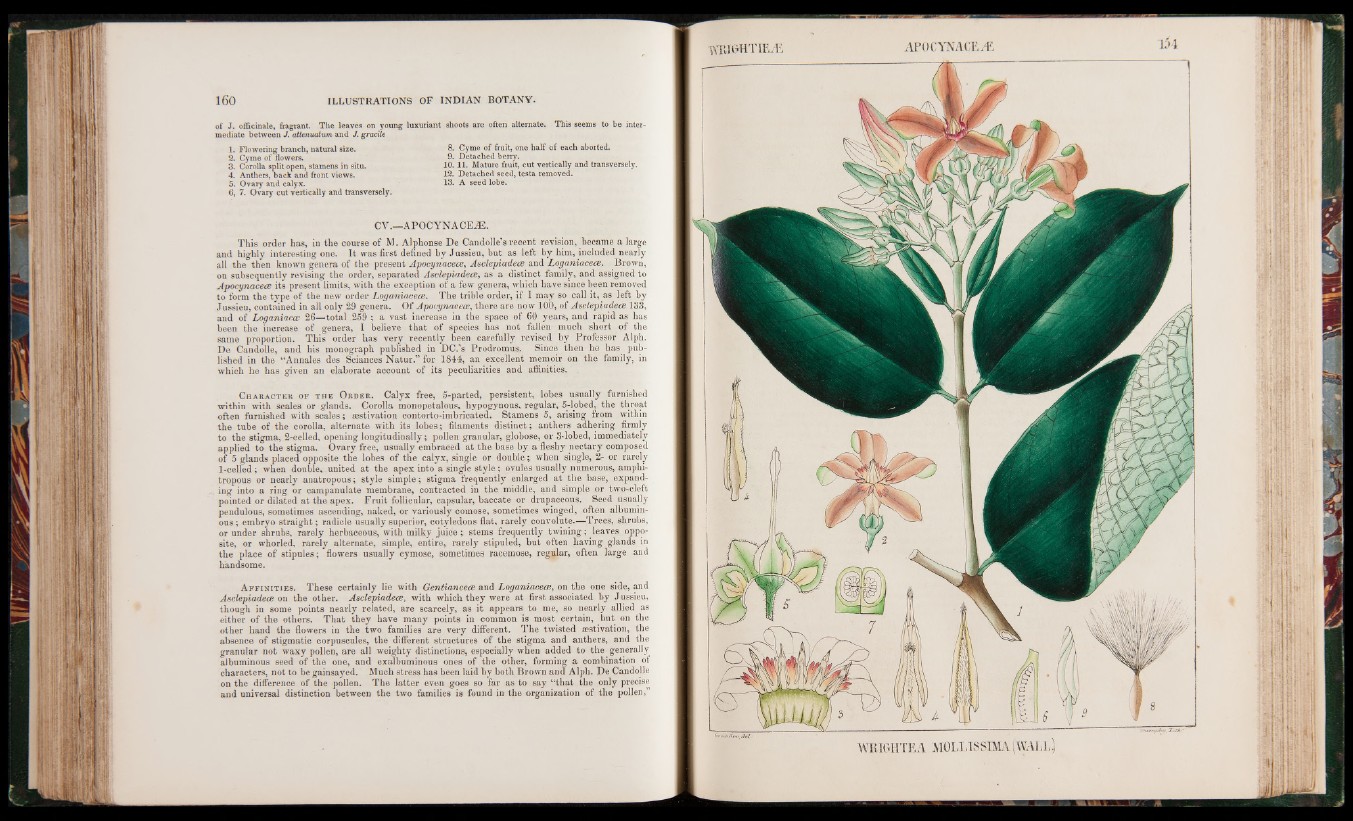
of J. officinale, fragrant The leaves on young luxuriant shoots are often alternate. This seems to be intermediate
between J. attenualum and J. gracile
1. Flowering branch, natural size.
2. Cyme of flowers.
3. Corolla split open, stamens in situ.
4. Anthers, back and front views.
5. Ovary and calyx.
6. 7. Ovary cut vertically and transversely.
8. Cyme of fruit, one half of each aborted.
9. Detached berry.
10. 11. Mature fruit, cut vertically and transversely.
12. Detached seed, testa removed.
13. A seed lobe.
c v .—APOCYNACEAS.
This order has, in the course of M. Alphonse De Candolle’s recent revision, became a large
and highly interesting one. It was first defined by Jussieu, but as left by him, included nearly
all the then known genera of the present Apocynacece, Asclepiadece and Loganiacece. Brown,
on subsequently revising the order, separated Asclepiadece, as a distinct family, and assigned to
Apocynacece its present limits, with the exception of a few genera, which have since been removed
to form the type of the new order Loganiacece. The trible order, if 1 may so call it, as left by
Jussieu, contained in all only 29 genera. Of Apocynacece, there are now 100, of Asclepiadece, 133,
and of Loganiacce 26—total 259 ; a vast increase in the space of 60 years, and rapid as has
been the increase of genera, I believe that of species has not fallen much short of the
same proportion. This order lias very recently been carefully revised by Professor Alph.
De Candolle, and his monograph published in DC.’s Prodromus, Since then he has published
in the “Annales des Sciances Natur.” for 1844, an excellent memoir on the family, in
which he has given an elaborate account of its peculiarities and affinities.
Character of the Order. Calyx free, 5-parted, persistent, lobes usually furnished
within with scales or glands. Corolla monopetalous, hypogynous, regular, 5-lobed, the throat
often furnished with scales; aestivation contorto-imbricated. Stamens 5, arising from within
the tube of the corolla, alternate with its lobes; filaments distinct; anthers adhering firmly
to the stigma, 2-celled, opening longitudinally; pollen granular, globose, or 3-lobed, immediately
applied to the stigma. Ovary free, usually embraced at the base by a fleshy nectary composed
of 5 glands placed opposite the lobes of the calyx, single or double; when single, 2- or rarely
1-celled; when double, united at the apex into a single style; ovules usually numerous, amphi-
tropous or nearly anatropous; style simple; stigma frequently enlarged at the base, expanding
into a ring or campanulate membrane, contracted in the middle, ^nd simple or two-cleft
pointed or dilated at the apex. Fruit follicular, capsular, baccate or drupaceous. Seed usually
pendulous, sometimes ascending, naked, or variously comose, sometimes winged, often albuminous
; embryo straight; radicle usually superior, cotyledons flat, rarely convolute.—Trees, shrubs,
or under shrubs, rarely herbaceous, with milky juice; stems frequently twining; leaves opposite,
or whorled, rarely alternate, simple, entire, rarely stipuled, but often having glands in
the place of stipules; flowers usually cymose, sometimes racemose, regular, often large and
handsome.
Affinities. These certainly lie with Gentiancece and Loganiacece, on the one side, and
Asclepiadece on the other. Asclepiadece, with which they were at first associated by J ussieu,
though in some points nearly related, are scarcely, as it appears to me, so nearly allied as
either of the others. That they have many points in common is most certain, but on the
other hand the flowers in the two families are very different. The twisted aestivation, the
absence of stigmatic corpuscules, the different structures of the stigma and anthers, and the
granular not waxy pollen, are all weighty distinctions, especially when added to the generally
albuminous seed of the one, and exalbuminous ones of the other, forming a combination of
characters, not to be gainsayed. Much stress has been laid by both Brown and Alph. De Candolle
on the difference of the pollen. The latter even goes so far as to say “that the only precise
and universal distinction between the two families is found in the organization of the pollen,’
!\TJ£HTIEÆ AP0CYNACEÆ